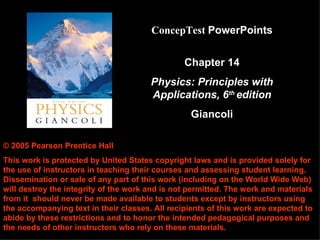
Thermal Physics Concept Tests
- 1. © 2005 Pearson Prentice Hall This work is protected by United States copyright laws and is provided solely for the use of instructors in teaching their courses and assessing student learning. Dissemination or sale of any part of this work (including on the World Wide Web) will destroy the integrity of the work and is not permitted. The work and materials from it should never be made available to students except by instructors using the accompanying text in their classes. All recipients of this work are expected to abide by these restrictions and to honor the intended pedagogical purposes and the needs of other instructors who rely on these materials. ConcepTest PowerPoints Chapter 14 Physics: Principles with Applications, 6 th edition Giancoli
- 2. ConcepTest 14.1a Thermal Contact I Two objects are made of the same material, but have different masses and temperatures. If the objects are brought into thermal contact, which one will have the greater temperature change? 1) the one with the higher initial temperature 2) the one with the lower initial temperature 3) the one with the greater mass 4) the one with the smaller mass 5) the one with the higher specific heat
- 3. ConcepTest 14.1a Thermal Contact I Two objects are made of the same material, but have different masses and temperatures. If the objects are brought into thermal contact, which one will have the greater temperature change? 1) the one with the higher initial temperature 2) the one with the lower initial temperature 3) the one with the greater mass 4) the one with the smaller mass 5) the one with the higher specific heat Since the objects are made of the same material, the only difference between them is their mass . Clearly, the object with less mass will be much easier to change temperature since there is not much material there (compared to the more massive object).
- 4. ConcepTest 14.1b Thermal Contact II Two different objects receive the same amount of heat. Which of the following choices is NOT a reason why the objects may have different temperature changes ? 1) they have different initial temperatures 2) they have different masses 3) they have different specific heats
- 5. ConcepTest 14.1b Thermal Contact II Two different objects receive the same amount of heat. Which of the following choices is NOT a reason why the objects may have different temperature changes ? 1) they have different initial temperatures 2) they have different masses 3) they have different specific heats Since Q = m c T and the objects received the same amount of heat, the only other factors are the masses and the specific heats. While the initial temperature is certainly relevant for finding the final temperature, it does not have any effect on the temperature change T .
- 8. ConcepTest 14.3a Night on the Field The specific heat of concrete is greater than that of soil. A baseball field (with real soil) and the surrounding parking lot are warmed up during a sunny day. Which would you expect to cool off faster in the evening when the sun goes down? 1) the concrete parking lot 2) the baseball field 3) both cool off equally fast
- 9. ConcepTest 14.3a Night on the Field The specific heat of concrete is greater than that of soil. A baseball field (with real soil) and the surrounding parking lot are warmed up during a sunny day. Which would you expect to cool off faster in the evening when the sun goes down? 1) the concrete parking lot 2) the baseball field 3) both cool off equally fast The baseball field, with the lower specific heat, will change temperature more readily, so it will cool off faster. The high specific heat of concrete allows it to “retain heat” better and so it will not cool off so quickly – it has a higher “thermal inertia.”
- 16. ConcepTest 14.6 Adding Heat If you add some heat to a substance, is it possible for the temperature of the substance to remain unchanged? 1) yes 2) no
- 17. ConcepTest 14.6 Adding Heat If you add some heat to a substance, is it possible for the temperature of the substance to remain unchanged? 1) yes 2) no Yes, it is indeed possible for the temperature to stay the same. This is precisely what occurs during a phase change – the added heat goes into changing the state of the substance (from solid to liquid or from liquid to gas) and does not go into changing the temperature! Once the phase change has been accomplished, then the temperature of the substance will rise with more added heat. Follow-up: Does that depend on the substance?
- 18. ConcepTest 14.7 Hot Potato Will potatoes cook faster if the water is boiling faster? 1) yes 2) no
- 19. ConcepTest 14.7 Hot Potato Will potatoes cook faster if the water is boiling faster? 1) yes 2) no The water boils at 100 °C and remains at that temperature until all of the water has been changed into steam. Only then will the steam increase in temperature. Since the water stays at the same temperature, regardless of how fast it is boiling, the potatoes will not cook any faster. Follow-up: How can you cook the potatoes faster?